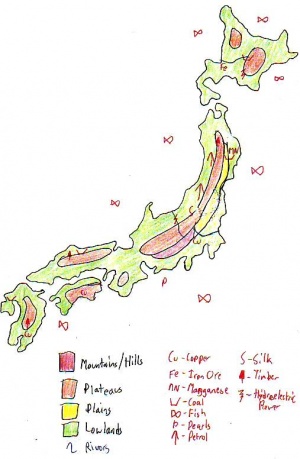World Cultures Portfolio/T-Shirt Trade
From ThePlaz.com
World Cultures Report about Global T-Shirt Industry
Africa: HDI Graph Reflections - Decolonization Report
Middle East: Population Density Report - Essay: A Peaceful Vacation
South Asia: Rainfall Report - South Asia Comparisons Graph - Postcards
China: Sphere of Influences Report - Mao Button Journal
Japan: Natural Resources Report - Japanese Violence Journal
Korea: Physical Map Report
Latin America: Landforms Report
Worldwide: T-Shirt Trade Report
The Travels of a T-Shirt in the Global Economy: An Economist Examines the Markets, Power, and Politics of World Trade explains the story (and politics) behind what it takes to produce a T-Shirt to be sold in America. The highly-complex system involves many people in many countries all working together to make a simple T-shirt which we can buy for only a few dollars.
After observing an anti-globalization protest in 1999, the author set out to find out if what these protesters said held true. The author, a collage professor at Georgetown University then set off to discover what went into a T-shirt. What she discovered held true to her theory, the generally accepted on by most economists, that globalization has helped us. Many poor countries like Taiwan and Japan have become much better off and it's helping China and India. But a T-shirt, both today and in the past, finds itself affected by creative maneuvers to avoid markets, not embrace them. The author finds that in every step of a T-shirt's life governments have attempted to regulate the textile industry, not force them to embrace competitive markets.
A t-shirt starts its life in Texas. As farmers moved to Texas, tractors first became popular. Old producers in the south relied on slave labor and did not adopt the tractors. In addition the partnership of universities and the Department of Agriculture research ideas which help our farmers. Today cotton farming requires almost no labor, only highly-specialized machines. The developing world can not compete with the private-public partnership and mechanization when some farmers can't even read. In addition, today the farmers own the plants which process and pack cotton. They band together in cooperatives to make sure their voice gets heard and that the profits go to them. Today a computer analyzes each bushel of cotton and places it onto an electronic sales system which connects the grower to the buyer. Lastly the government provides billions of dollars in subsidies to both cotton growers and buyers. Growers face no risk of bad weather because they know that the US government will subsidies them.
In China, the state-run factories must cope with producing for a market not a state quota. The managers must know worry about quality as well as quantity. No longer can they just focus on producing Mao jackets, they must worry about all of the different styles of cloth. The workers who many say work under "sweatshop" conditions generally prefer a factory over a farm. For years, going back to the British and American textile mills, the factories needed docile young girls willing to work. These girls come from farms where one must work hard and in many cases deal with an abusive father. They enjoy the bit of independence they do have; no longer must they be attached to their father's wishes. They must not stand out in the sun all day then rise at 3 AM to harvest crops. Again mechanization has come here making the job easier and safer.
However the T-shirts trip back to America
Despite promising free trade, the politicians have developed thousands and thousands of laws regarding textile imports. However, when she is done with her shirt, it finally encounters a free market in the highly competitive fabric recycling industry.
Sources
- Rivoli, Pietra. The Travels of a T-Shirt in the Global Economy: An Economist Examines the Markets, Power, and Politics of World Trade. Hoboken: Wiley, 2005.



